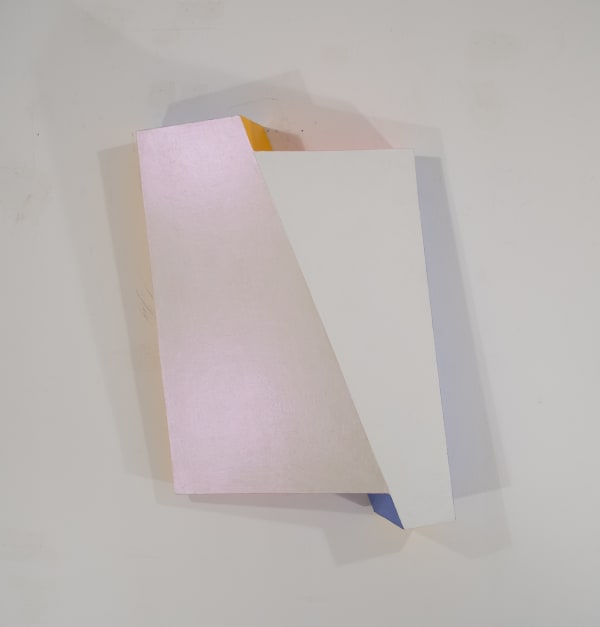Charles Hinman: Chromatic Eclipse
-
 Charles Hinman, Meeting Point, 1969
Charles Hinman, Meeting Point, 1969 -
 Charles Hinman, Reflector, 2008
Charles Hinman, Reflector, 2008 -
 Charles Hinman, Green Interference, 2008
Charles Hinman, Green Interference, 2008 -
 Charles Hinman, Pearl Interference, 2008
Charles Hinman, Pearl Interference, 2008
-
 Charles Hinman, Peach Twist, 2011
Charles Hinman, Peach Twist, 2011 -
 Charles Hinman, Blue Twist, 2011
Charles Hinman, Blue Twist, 2011 -
 Charles Hinman, Chromatic Three, 2009
Charles Hinman, Chromatic Three, 2009 -
 Charles Hinman, Docking in Space, 1970
Charles Hinman, Docking in Space, 1970
-
 Charles Hinman, Color River, 2008
Charles Hinman, Color River, 2008 -
 Charles Hinman, Leaning Twist, 2010
Charles Hinman, Leaning Twist, 2010 -
 Charles Hinman, Fair Harbour, 1989
Charles Hinman, Fair Harbour, 1989 -
 Charles Hinman, Eclipse, 2010
Charles Hinman, Eclipse, 2010
-
 Charles Hinman, Shattered Bird, circa mid-2000s
Charles Hinman, Shattered Bird, circa mid-2000s -
 Charles Hinman, Analogous Eclipse, 2010
Charles Hinman, Analogous Eclipse, 2010 -
 Charles Hinman, Citi Rose, circa 1980s
Charles Hinman, Citi Rose, circa 1980s -
 Charles Hinman, Study for Flying Four, 1974
Charles Hinman, Study for Flying Four, 1974
WESTWOOD GALLERY NYC was pleased to present a solo exhibition of paintings by New York artist Charles Hinman (b. 1932). The exhibition takes its name from a painting within Hinman’s 2010 Eclipse series and highlights shaped paintings with concealed color hues emanating behind canvases of white and black. Chromatic Eclipse included 20 paintings from the 1960s until the 2010s. The exhibition is concurrent with the closing week of a retrospective of his work at The Kreeger Museum in Washington D.C., on view until July 31.
Charles Hinman’s career spans five decades, stemming from his debut at the historic Sidney Janis Gallery in the early 1960s and his inclusion in the breakthrough show Shape and Structure: 1965 at Tibor de Nagy Gallery. Art historian and specialist in Minimalism James Meyer wrote “Submitting simple geometries to optical dynamics, the isometric illusionism of Stella, Larry Bell, Charles Hinman, Neil Williams, Will Insley, Ronald Davis, and the Park Place artists, was the structural answer to Op Art.” Claudine Humblet writes about Hinman in her reference book, The New American Abstraction: 1950-1970, as seeking “a new relationship between the form and the wall space it addresses in an abundance of formal invention” and observes the work “operates in the ‘real’ space and in the realm of ‘illusion’ at the same time.”
In some of the works in the exhibition, like Meeting Point (1969), the dichromatic, geometric structure of the canvas opened the door for Hinman to explore hue, light, and form in direct opposition to the patterned effect of Op art. In another, such as Fair Harbour (1989), Hinman introduces shadow into his three-dimensional work, shifting the perception of color across structured curvatures in a pursuit of complexity by simple means. And in his more recent bodies of work, like Analogous Eclipse (2010), the dimensionality of the canvas folds into the wall, reflecting auras of color at changing intensities.
Charles Hinman
Born and raised in Syracuse, New York, Hinman received his BFA from Syracuse University in 1955 and went on to study at the Arts Student League of New York. In the early 1960s he shared a studio with James Rosenquist on the historic Coenties Slip in Lower Manhattan. There, he was part of a community of prominent artists including Agnes Martin, Robert Indiana, and Ellsworth Kelly. He moved into a larger studio on the Bowery in 1965 alongside Will Insley and Max Gimblett, where he lived until 2018. During his Bowery years, Hinman’s work has been exhibited and collected by major institutions and collectors around the world. His artwork is included in the permanent collections of the Whitney Museum of American Art, the Museum of Modern Art, the Los Angeles County Museum of Art, the Hirschhorn Museum and Sculpture Garden, the Denver Art Museum, the Nagaoka Museum in Japan, the Tel Aviv Museum in Israel, among others. He is the recipient of Guggenheim Fellowship and four Pollock-Krasner Foundation grants.






























